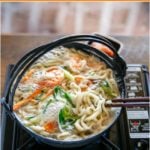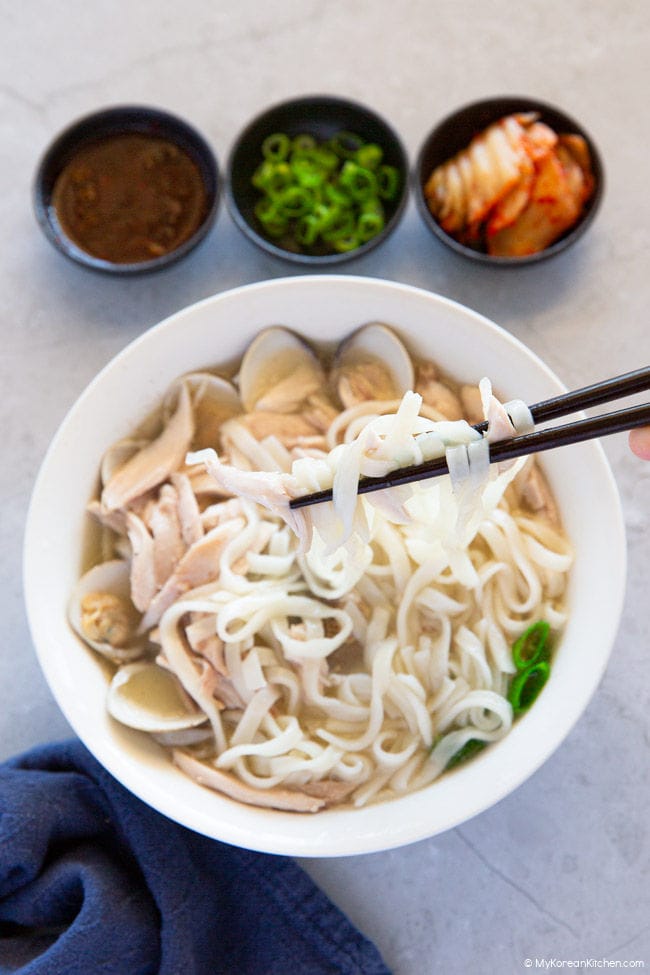Kalguksu (Korean knife-cut noodle soup) is a light, refreshing, and comforting noodle soup. It will warm your heart, mind, and soul!
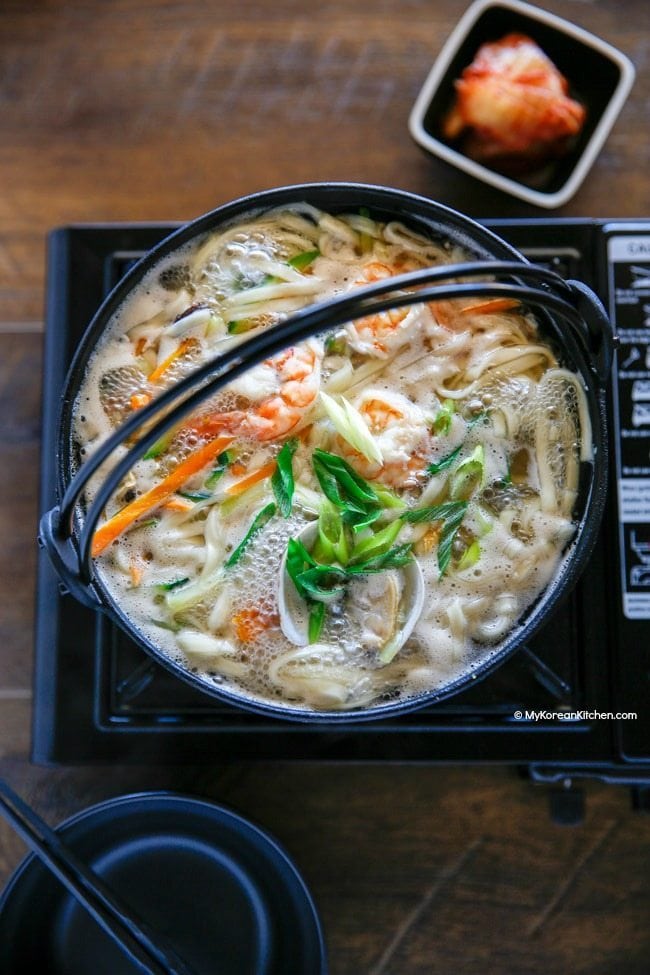
Kalguksu (칼국수) is one of my favorite noodle soups. Unlike jjampong (짬뽕, Korean spicy seafood noodle soup), kalguksu is not spicy.
One of the best parts of kalguksu is the handmade knife-cut noodles — soft, chewy, and so satisfying. These thin, flat noodles have a wonderfully bouncy texture — and when paired with the clean, savory broth, it becomes the kind of cozy, everyday meal that’s easy to crave.
I usually buy pre-made kalguksu noodles from a Korean grocery store — they’re quick, easy, and perfect for busy days. Making them from scratch adds about 1 hour and 25 minutes to the process, so I don’t always do it. But if you’re curious, I have a homemade kalguksu noodles recipe you can try — the rustic texture and chew of freshly made noodles bring a whole new level of comfort to this dish!
Popular Types of Kalguksu
There are a few delicious variations of kalguksu, but my number one choice has always been Bajirak Kalguksu (바지락 칼국수) — knife-cut noodle soup with littleneck clams. I’m not exactly sure what it is, but I absolutely love the light, refreshing flavor that comes from these little shellfish.
Since I’m a seafood lover, I often throw in a few prawns as well. If you’re not adding prawns, you can simply increase the amount of littleneck clams.
I’ve also seen some Koreans add squid or baby octopus to their kalguksu, which looks so tempting. When I use more than just clams, I call it Haemul Kalguksu (해물 칼국수) — knife-cut noodle soup with mixed seafood.
Another well-loved variation is Dak Kalguksu (닭 칼국수), made with chicken. This version has a deeper, richer flavor thanks to the broth. Typically, these heartier soups are additionally seasoned at the table — with salt, pepper, or even a bit of spicy chili sauce, depending on your taste.
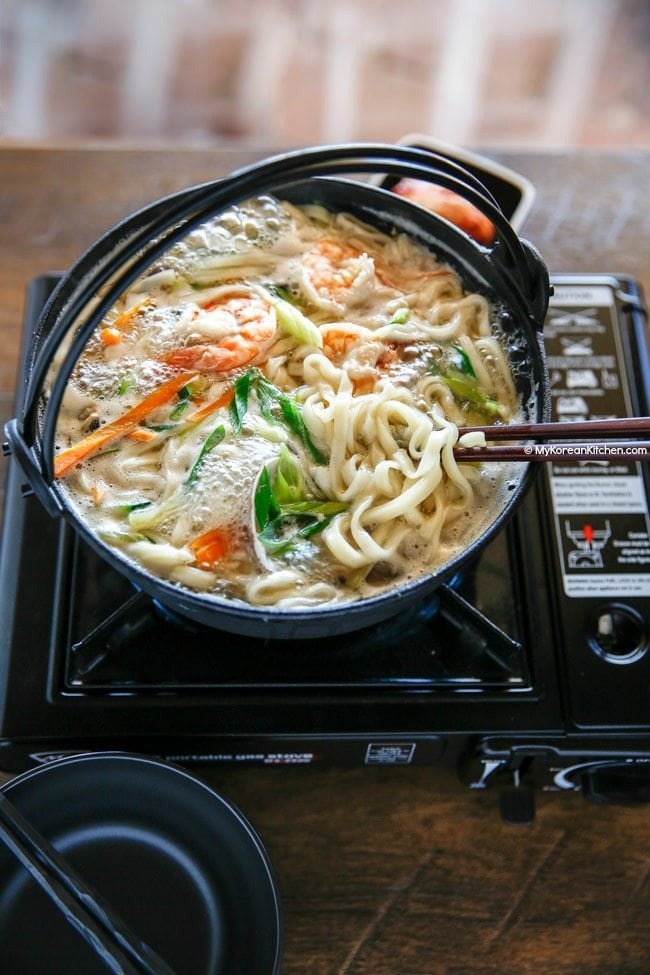
What to Serve with
Since both the noodles and broth in kalguksu are mild and comforting, the best pairing is — of course — kimchi. It goes especially well with freshly made kimchi salad or cubed radish kimchi (kkakdugi) for a bit of crunch and brightness on the side.
Kalguksu is true comfort food. I especially love having it on a cold, rainy day or during winter — it really warms you from the inside out. I hope you enjoy this recipe as much as I do!
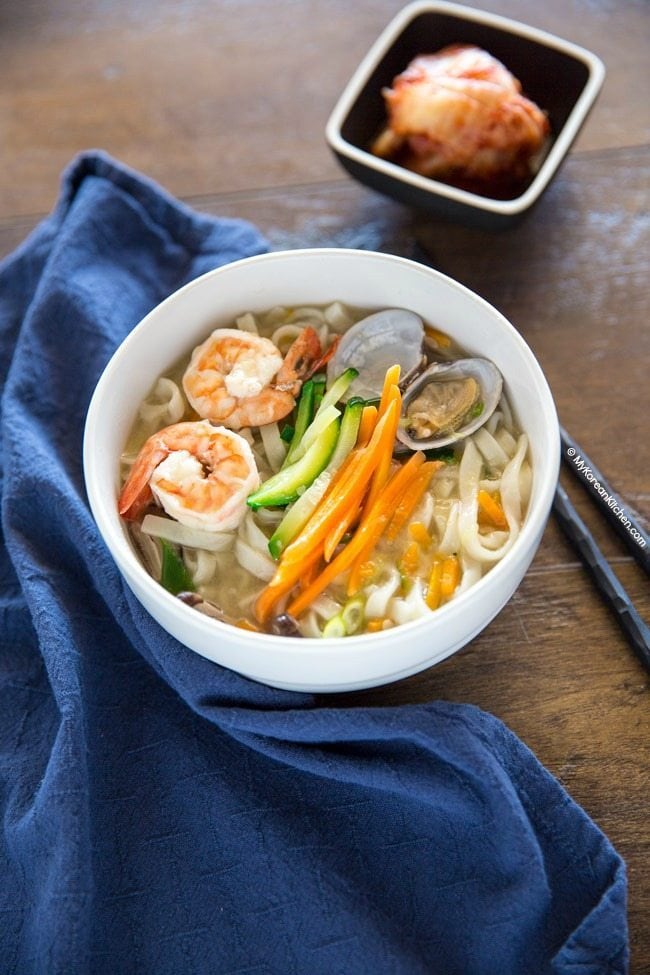
Ingredients (Serving 2)
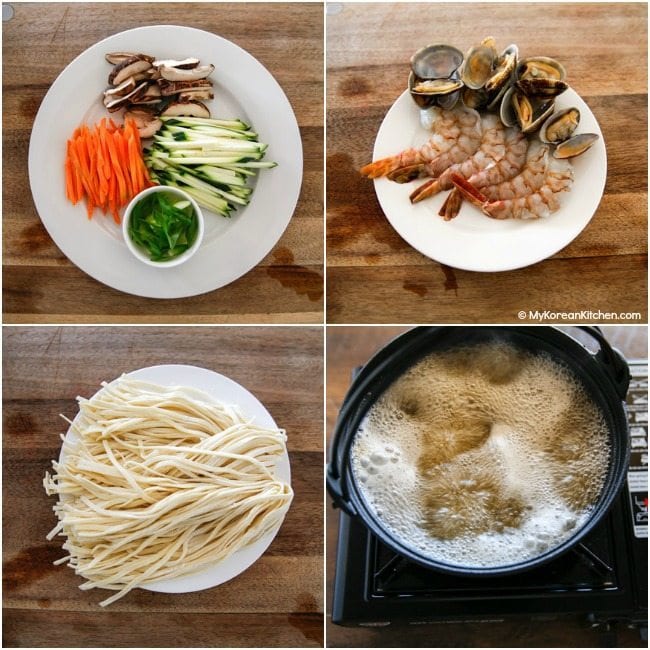
- About 4 and 1/2 cups dried anchovy and kelp stock or water (*see note)
- 1 tsp soy sauce (I used regular kikkoman soy sauce)
- 1/2 tsp minced garlic
- 1/2 tsp fine sea salt (or more to taste)
- 300g/ 10 ounces knife-cut noodles (kalguksu noodles), Store-bought is fine, or make homemade noodles if you prefer
- Some water to boil the noodles
- 100g / 3.5 ounces zucchini, julienned
- 50g / 1.7 ounces carrot, julienned
- 40g / 1.4 ounces shiitake mushrooms, thinly sliced
- 130g / 4.5 ounces fresh/frozen littleneck clam (weight includes the shells), cleaned /defrosted if frozen
- 100g / 3.5 ounces prawn, head and tail removed, deveined
- 10g / 0.3 ounces green onion, chopped
*1 Tbsp = 15 ml, 1 Cup = 250 ml
How to Make Kalguksu
1. Bring the anchovy and kelp stock to a boil over medium heat. Add the soy sauce, minced garlic, and salt to season the broth. Once the stock reaches a rolling boil, add the zucchini, carrots, and shiitake mushrooms. Cook for about 2 minutes, or until just slightly softened. Then add the clams and prawns, and continue boiling for another 2 minutes, or until they’re just cooked through. Avoid overcooking, as the seafood can become tough and gummy.
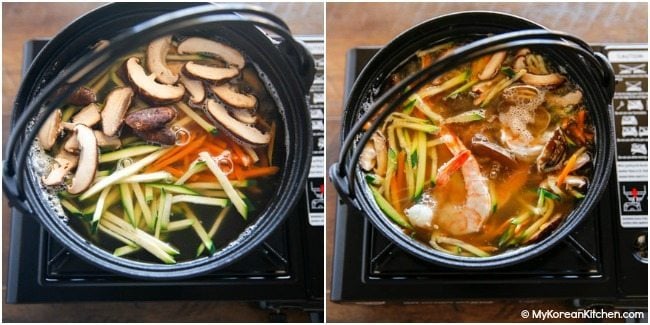
2. (Ideally at the same time as Step 1) In a separate pot, boil the noodles in rapidly boiling water for 2 to 3 minutes, or until cooked. Drain and rinse under cold running water, then set aside.

3. Add the noodles to the soup pot (from Step 1) and boil for about 1 minute to warm them through. Give them a gentle stir. Add the green onion, then turn off the heat. Serve hot.

Note
- If you’re using water instead of anchovy and kelp stock, you’ll need to add more soy sauce and/or salt to season the soup, as it will lack depth of flavor. Just be careful — too much soy sauce can darken the broth, giving it a brownish color. The typical color of this style of kalguksu soup is quite clear.
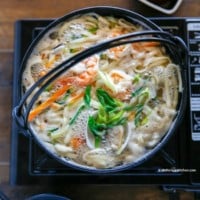
Kalguksu (Korean Knife Cut Noodle Soup)
Ingredients
- 4 1/2 cups Dried kelp and dried anchovy stock or water (*see note above)
- 1 tsp soy sauce , (I used regular kikkoman soy sauce)
- 1/2 tsp minced garlic
- 1/2 tsp fine sea salt (or more to taste)
- 300 g knife-cut noodles (kalguksu noodles), Store-bought is fine, or make homemade noodles if you prefer (10 ounces)
- Some water to boil the noodles
- 100 g zucchini (3.5 ounces), julienned
- 50 g carrot (1.7 ounces), julienned
- 40 g shiitake mushrooms (1.4 ounces), thinly sliced
- 130 g fresh / frozen littleneck clam (4.5 ounces), (weight includes the shells), cleaned / defrosted if frozen
- 100 g prawn (3.5 ounces), head and tail removed, deveined
- 10 g green onion (0.3 ounces), chopped
Instructions
- Bring the anchovy and kelp stock to a boil over medium heat. Add the soy sauce, minced garlic, and salt to season the broth. Once the stock reaches a rolling boil, add the zucchini, carrots, and shiitake mushrooms. Cook for about 2 minutes, or until just slightly softened. Then add the clams and prawns, and continue boiling for another 2 minutes, or until they’re just cooked through. Avoid overcooking, as the seafood can become tough and gummy.
- (Ideally at the same time as Step 1) In a separate pot, boil the noodles in rapidly boiling water for 2 to 3 minutes, or until cooked. Drain and rinse under cold running water, then set aside.
- Add the noodles to the soup pot (from Step 1) and boil for about 1 minute to warm them through. Give them a gentle stir. Add the green onion, then turn off the heat. Serve hot.
Notes
- Using water instead of anchovy-kelp stock? Add more soy sauce and/or salt for flavor—but not too much soy sauce, or the broth will turn brown. This soup is traditionally light and clear.
- Kalguksu pairs perfectly with kimchi—especially fresh kimchi salad or radish kimchi (kkakdugi) for crunch and brightness.
Nutrition Info (per serving)
The nutrition information shown is an estimate provided by an online nutrition calculator. It should not be considered a substitute for a professional nutritionist’s advice.
